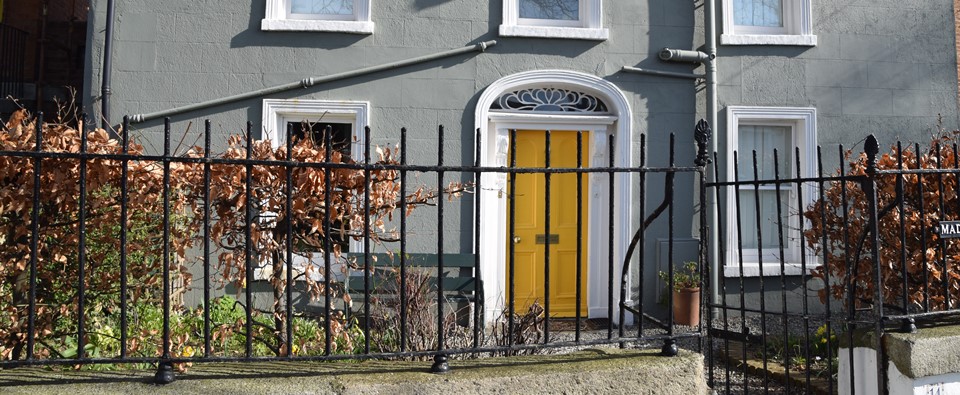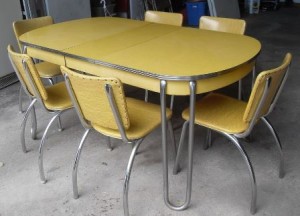39 The Gray House with the Yellow Door
Posted by Christine on Mar 16, 2015 in Ireland | 1 comment
Spring has come to Dublin, first with the bevy of tour buses appearing in Nassau Street alongside Trinity College and the school groups from Italy and Japan gathering around the steps of the museums and encircling monuments like the  Molly Malone statue in Suffolk Street or the Fusiliers Arch at Stephen’s Green. November and January are really the only months in the year when Dublin isn’t mobbed with tourists.
Molly Malone statue in Suffolk Street or the Fusiliers Arch at Stephen’s Green. November and January are really the only months in the year when Dublin isn’t mobbed with tourists.
Though the cold has by no means gone away, when I call up the “10 day” outlook for Dublin on weather.com, more 50s than 40s appear as the highs. In the shop windows on Grafton Street, the palette has changed from winter colors to the bright pastels of spring and summer, though it’s not yet time to wear those flimsy items of clothing. I’m still taking my wool scarf when I go shopping. Today The Irish Times reported that the rooks are starting to build their nests and showed one in flight with a beak full of twigs. In the last two weeks I’ve noticed the snowdrops, crocuses, primroses, and daffodils on every available patch of ground or flower pot. Especially the daffodils. Heads bobbing in the March winds, these graceful flowers don’t last more than a day or two in a vase and seem to live their few weeks in the soil just to let us know that spring is coming.
The other day we were walking home from the grocery store in Sandymount when we passed by the gray house with the yellow door and daffodils in the yard pictured at the top. I grew up in a gray house with a yellow door on Kedzie Street in Evanston, Illinois. The ramshackle Victorian surrounded by a white picket fence was a child’s dream with its nooks and crannies, bay windows, stair landings, and magical attic. My brothers and I had special games for each of the two landings; the attic was where we played “the olden days,” a game that usually had me as the teacher in a one-room pioneer schoolhouse. There was a thrillingly scary “furnace room” in the basement and a walk-in “linen closet” upstairs that had great cupboards for hiding. My dad built a huge sandbox in the back yard that overlooked the yards of four different neighbors’ houses, so there was always someone to talk to or spy on.
The house was gray when we moved in, though I know we repainted it at least once. Shortly after our arrival, my mother insisted on having the front door painted yellow. Everyone thought she was crazy. Gray houses had black doors, or if you wanted to be really daring, red doors. Friends and relatives insisted she should paint ours red. But my mother loved yellow and wouldn’t let anyone dissuade her. She made the kitchen of that house all yellow, including a wonderful yellow and white gingham formica and chrome dinette set that would be worth a fortune today if only we had saved it. The gray and yellow theme was continued in the living room, too, with its yellow cafe curtains, yellow silk lampshades, and gray sofa. She even painted a botanical image of an onion plant in gray and yellow to hang in there. I still have that painting. But the yellow door was the stunner, and when the daffodils or yellow tulips were in bloom, the plain boxy house looked like something from a storybook. Years later when I’d meet people from the old neighborhood, whether I knew them or not they remembered “the gray house with the yellow door.”
We moved across town when I was nine so we would be closer to my dad’s work, an office in the Old Orchard Shopping Center, one of the first of the suburban malls that would soon transform shopping in our area and others. I fought that move with all the righteous indignation a nine-year-old could muster, telling anyone who would listen that the house we were moving to—a perfectly nice neo-Tudor revival in North Evanston—“looks like a witch’s house!” I didn’t want to leave my school, my friends, the neighborhood that was only a block or two from Lake Michigan, or the house. On moving day I sobbed in my room for hours: how could they do this to me? When I thought no one was looking, I pulled down the blue flowered curtains that matched the wallpaper and were to be left for the new owners, stuffing them into my kiddie suitcase and spiriting them out of the house. Then as now, small acts of rebellion were bound to make me feel better. I smuggled the balled up curtains into my new room in the witch’s house, hiding them in the closet and using them as a kind of security blanket until I got used to the new place, new school, and new friends. Eventually, they disappeared.
Just a few weeks ago a photograph of the old house on Kedzie Street popped up on a Facebook page for current and former residents of Evanston. The photo shows neighbors digging their cars out of the snow, and my old house is simply the backdrop for the scene. I was thrilled to see it online—the image seemed almost like a message directed to me. The house had been neglected at various times in the past; not long ago it was for sale for a price well below the market rate  in that neighborhood, so my brothers and I knew it must be in bad shape. Now it looks better than it has in years: the current owners seem to be taking good care of it. They have what looks like a black and white front door, and I’m sure it’s very elegant, but the yellow door of long ago gave a special character to the house, as it does to the house here in Dublin.
in that neighborhood, so my brothers and I knew it must be in bad shape. Now it looks better than it has in years: the current owners seem to be taking good care of it. They have what looks like a black and white front door, and I’m sure it’s very elegant, but the yellow door of long ago gave a special character to the house, as it does to the house here in Dublin.
I grew up disliking the color yellow, but nowadays I can’t get enough of it. Someday I want to live in a yellow house, like the one I can see every day in my “view from here,” and plant daffodils all around it to let me know when it’s spring. My father always encouraged me to be “different,” to stand apart from the crowd, and probably to his own regret, to rebel; my mother’s yellow door showed me how to make that difference come to be.




Love the dinette set! Do “dinette sets” even exist anymore?